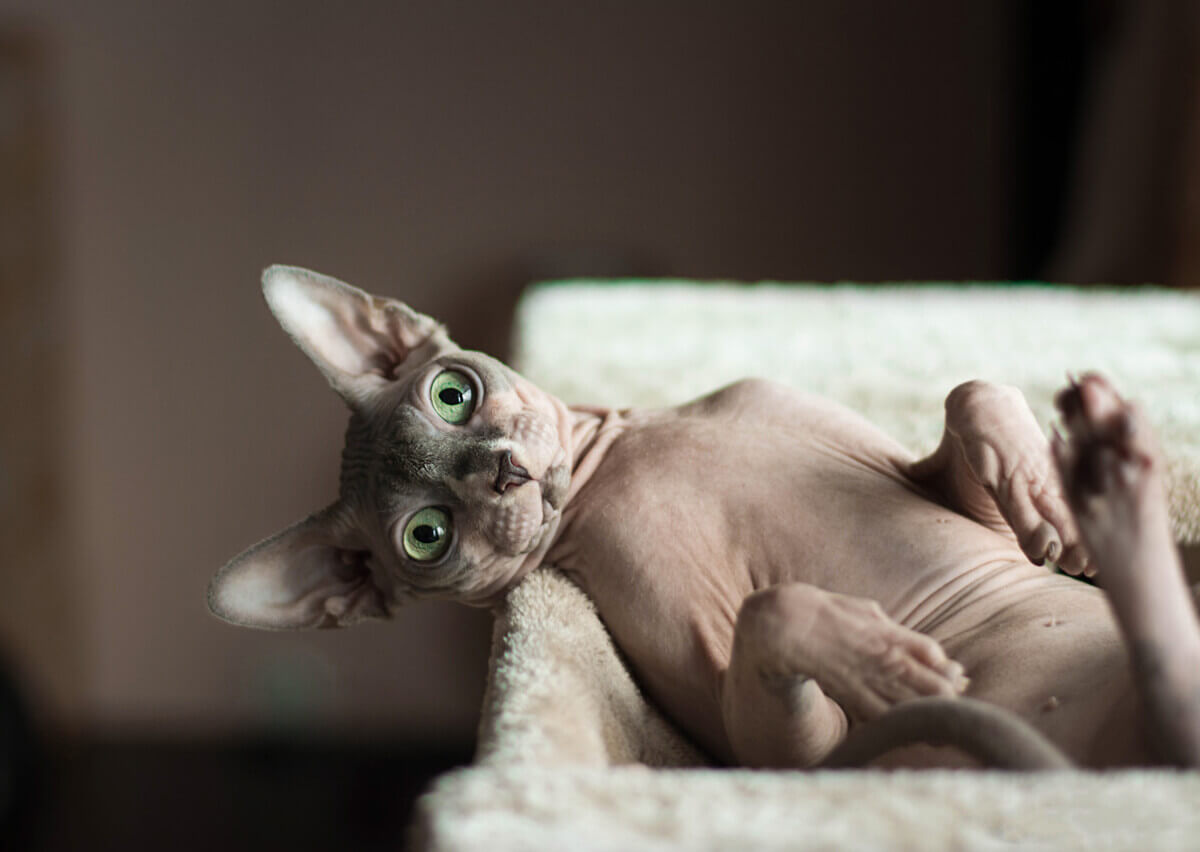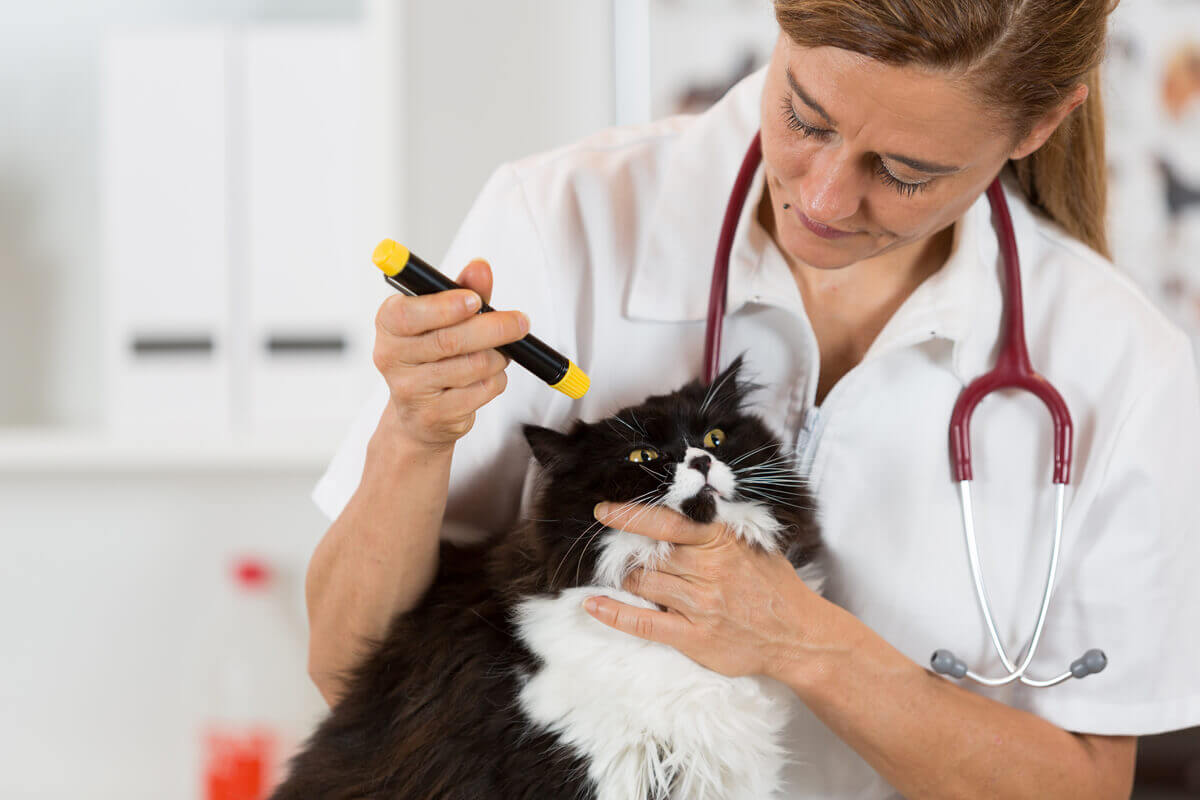6 Genetic Diseases in Cats

Experts study genetic diseases to improve reproduction in many animal species. In dogs, cats, horses, and other living beings, they’re an important factor in the selection for the breeding and preservation of breeds. For this reason, genetic diseases in cats are common.
Experts have discovered about 60 genes and mutations responsible for clinical conditions in cats. In fact, cats can suffer from more than 300 genetic diseases, many of them similar to human conditions. In this article, we’ll tell you everything you need to know about the most important ones.
6 genetic diseases in cats
Scientific advances in the knowledge of the genome of species are making it possible to identify the molecular foundations of different genetic diseases. Experts are studying them in cats as well, as this breed accompanies humans and its health is a key issue in veterinary medicine.
This allows the development of genetic analyzes for diagnostic purposes, useful to confirm diseases in asymptomatic specimens and for the control and elimination of genetic diseases in a population. Thanks to these techniques, we can avoid crossing specimens that are carriers of harmful mutations.
Unfortunately, some diseases continue to affect domestic cats today, depending on their breed and genome. Here are the 6 most common hereditary diseases in cats.

1. Polycystic kidney disease (PKD), the most common hereditary disease in cats
Polycystic kidney disease is an autosomal dominant genetic disease that affects Persian cats and their crossbreeds, Burmese cats, and British Shorthairs, among others. Experts consider it to be the most common genetic disease in cats, as the Persian is one of the most popular cats around the world.
This condition causes the appearance of small, closed, fluid-filled kidney cysts that can be detected with an ultrasound. Over time, the cysts grow and multiply, impairing kidney function, and, ultimately, causing chronic kidney failure.
The cat can even be born with these cysts. However, they’re usually detected by ultrasound when the cat is about six months of age. Experts estimate that up to 50% of Persian cats will suffer from polycystic kidney disease.
2. Hypertrophic cardiomyopathy (HCM)
Hypertrophic cardiomyopathy is the most common heart disease in domestic cats and is also inherited in breeds such as the Maine Coon and Ragdoll. The condition causes the muscular walls of a cat’s heart to thicken.
A point mutation in the gene that encodes the protein of the fibers of the heart muscle causes this cardiomyopathy. Cats who have this mutation can be affected in several ways. In fact, the most severe cases usually result in heart failure.
3. Spinal muscular atrophy (SMA)
This is an autosomal recessive disorder that usually manifests when a cat is 12 weeks of age. Neuron loss causes skeletal muscle atrophy and weakness in the cat.
Symptoms range from an abnormal gait and posture to an inability to jump and climb, exercise intolerance, sensitivity to back rubbing, and, also, shortness of breath. Affected cats can reach adulthood, since the disease isn’t fatal, albeit disabling. Sick cats require special care throughout their lives.
4. Progressive retinal atrophy (PRA)
Affected cats are born with completely normal vision. However, changes in their retina occur when they’re approximately one and a half to two years of age. The rods, which are the cells in charge of detecting motion, night vision, and peripheral vision, progressively degenerate. The photoreceptor cells are also affected.
The final result of the degeneration of both types of photoreceptors is blindness, which occurs when the affected cat is between three and five years of age. Some of the cat breeds that are most likely to suffer from progressive retinal atrophy are the Abyssinian, Somali, Siamese, Singapuran, and Tonkinese, among others.
5. Pyruvate kinase deficiency
A deficiency of the pyruvate kinase enzyme in erythrocytes causes inherited hemolytic anemia in Abyssinian, Somali, and domestic short-haired cats. It’s another of the most common hereditary diseases in cats.
The cat’s body doesn’t have enough healthy red blood cells to provide oxygen to the various tissues. Red blood cells are destroyed earlier than normal, which causes symptoms such as severe lethargy, diarrhea, pale mucous membranes, loss of appetite, and weight loss. It can be detected with blood tests.
6. Gangliosidosis
Gangliosidosis is an inherited neurodegenerative disease that a point mutation in a gene causes. This condition was first described in Siamese cats and then in the Korat.
Neurological symptoms appear when affected cats are three and a half months old. The first ones are usually slight tremors in the head or extremities. As the disease progresses, sick cats suffer from abnormal gait, blindness, and seizures in the terminal stage of the disease, when they’re approximately nine to ten months of age.

These are the 6 most common inherited diseases in cats. If you’re planning to buy a cat belonging to any of the breeds we mentioned above, then go to a trusted breeder and also read about the possible diseases it may develop over time. In addition, you should read up on the genetic tests that are available on the market.
Experts study genetic diseases to improve reproduction in many animal species. In dogs, cats, horses, and other living beings, they’re an important factor in the selection for the breeding and preservation of breeds. For this reason, genetic diseases in cats are common.
Experts have discovered about 60 genes and mutations responsible for clinical conditions in cats. In fact, cats can suffer from more than 300 genetic diseases, many of them similar to human conditions. In this article, we’ll tell you everything you need to know about the most important ones.
6 genetic diseases in cats
Scientific advances in the knowledge of the genome of species are making it possible to identify the molecular foundations of different genetic diseases. Experts are studying them in cats as well, as this breed accompanies humans and its health is a key issue in veterinary medicine.
This allows the development of genetic analyzes for diagnostic purposes, useful to confirm diseases in asymptomatic specimens and for the control and elimination of genetic diseases in a population. Thanks to these techniques, we can avoid crossing specimens that are carriers of harmful mutations.
Unfortunately, some diseases continue to affect domestic cats today, depending on their breed and genome. Here are the 6 most common hereditary diseases in cats.

1. Polycystic kidney disease (PKD), the most common hereditary disease in cats
Polycystic kidney disease is an autosomal dominant genetic disease that affects Persian cats and their crossbreeds, Burmese cats, and British Shorthairs, among others. Experts consider it to be the most common genetic disease in cats, as the Persian is one of the most popular cats around the world.
This condition causes the appearance of small, closed, fluid-filled kidney cysts that can be detected with an ultrasound. Over time, the cysts grow and multiply, impairing kidney function, and, ultimately, causing chronic kidney failure.
The cat can even be born with these cysts. However, they’re usually detected by ultrasound when the cat is about six months of age. Experts estimate that up to 50% of Persian cats will suffer from polycystic kidney disease.
2. Hypertrophic cardiomyopathy (HCM)
Hypertrophic cardiomyopathy is the most common heart disease in domestic cats and is also inherited in breeds such as the Maine Coon and Ragdoll. The condition causes the muscular walls of a cat’s heart to thicken.
A point mutation in the gene that encodes the protein of the fibers of the heart muscle causes this cardiomyopathy. Cats who have this mutation can be affected in several ways. In fact, the most severe cases usually result in heart failure.
3. Spinal muscular atrophy (SMA)
This is an autosomal recessive disorder that usually manifests when a cat is 12 weeks of age. Neuron loss causes skeletal muscle atrophy and weakness in the cat.
Symptoms range from an abnormal gait and posture to an inability to jump and climb, exercise intolerance, sensitivity to back rubbing, and, also, shortness of breath. Affected cats can reach adulthood, since the disease isn’t fatal, albeit disabling. Sick cats require special care throughout their lives.
4. Progressive retinal atrophy (PRA)
Affected cats are born with completely normal vision. However, changes in their retina occur when they’re approximately one and a half to two years of age. The rods, which are the cells in charge of detecting motion, night vision, and peripheral vision, progressively degenerate. The photoreceptor cells are also affected.
The final result of the degeneration of both types of photoreceptors is blindness, which occurs when the affected cat is between three and five years of age. Some of the cat breeds that are most likely to suffer from progressive retinal atrophy are the Abyssinian, Somali, Siamese, Singapuran, and Tonkinese, among others.
5. Pyruvate kinase deficiency
A deficiency of the pyruvate kinase enzyme in erythrocytes causes inherited hemolytic anemia in Abyssinian, Somali, and domestic short-haired cats. It’s another of the most common hereditary diseases in cats.
The cat’s body doesn’t have enough healthy red blood cells to provide oxygen to the various tissues. Red blood cells are destroyed earlier than normal, which causes symptoms such as severe lethargy, diarrhea, pale mucous membranes, loss of appetite, and weight loss. It can be detected with blood tests.
6. Gangliosidosis
Gangliosidosis is an inherited neurodegenerative disease that a point mutation in a gene causes. This condition was first described in Siamese cats and then in the Korat.
Neurological symptoms appear when affected cats are three and a half months old. The first ones are usually slight tremors in the head or extremities. As the disease progresses, sick cats suffer from abnormal gait, blindness, and seizures in the terminal stage of the disease, when they’re approximately nine to ten months of age.

These are the 6 most common inherited diseases in cats. If you’re planning to buy a cat belonging to any of the breeds we mentioned above, then go to a trusted breeder and also read about the possible diseases it may develop over time. In addition, you should read up on the genetic tests that are available on the market.
All cited sources were thoroughly reviewed by our team to ensure their quality, reliability, currency, and validity. The bibliography of this article was considered reliable and of academic or scientific accuracy.
- Universidad Complutense de Madrid. Patologías hereditarias en la especie felina.
- Patologías hereditarias en el gato. Sevane N, Dunner S. Laboratorio de Genética. Dpto. de Producción Animal. Facultad de Veterinaria, UCM.
This text is provided for informational purposes only and does not replace consultation with a professional. If in doubt, consult your specialist.








